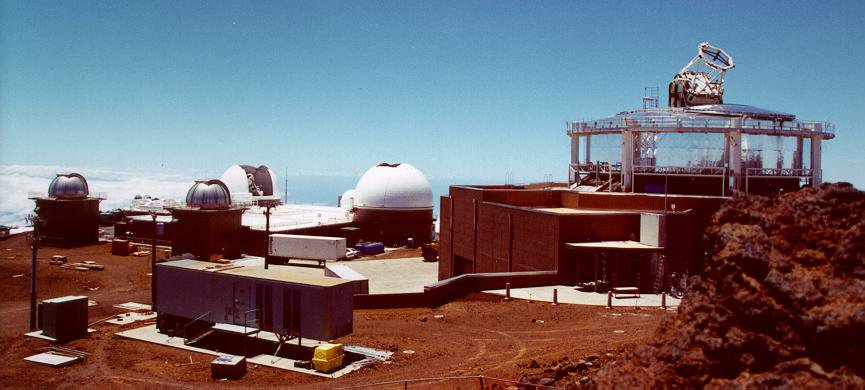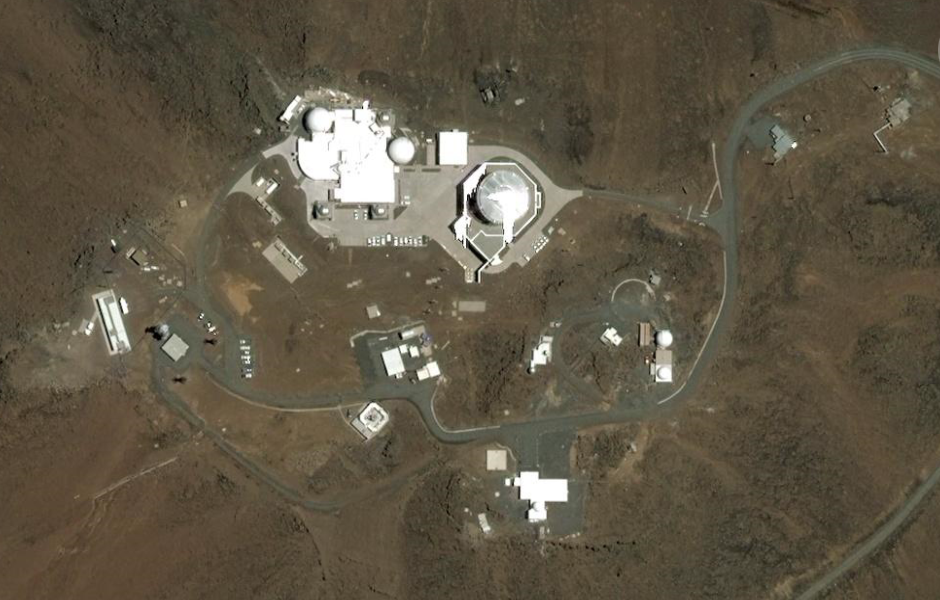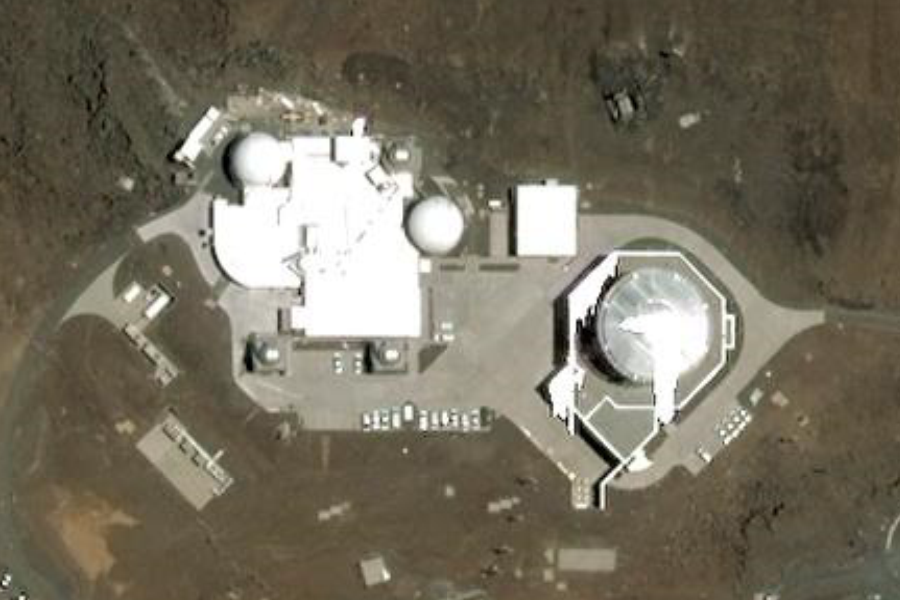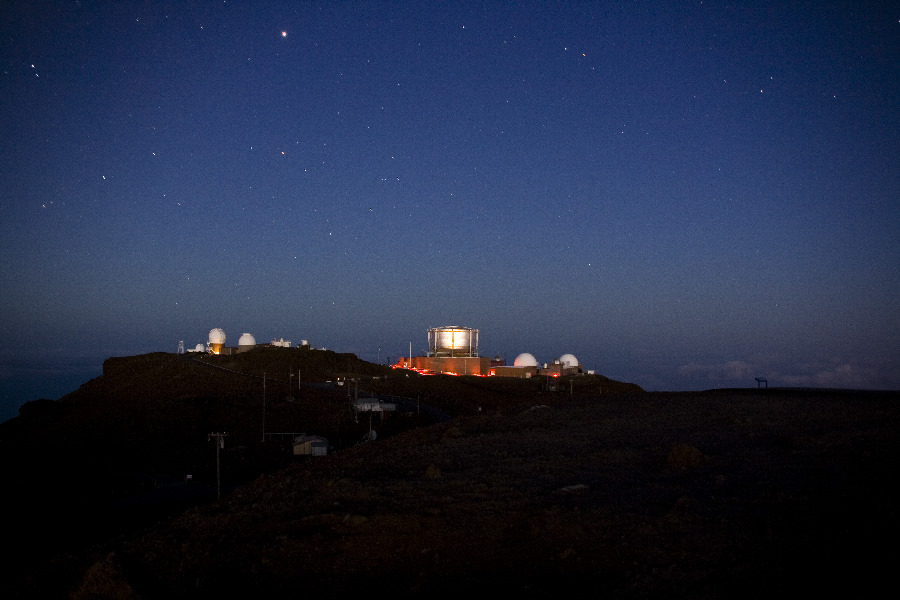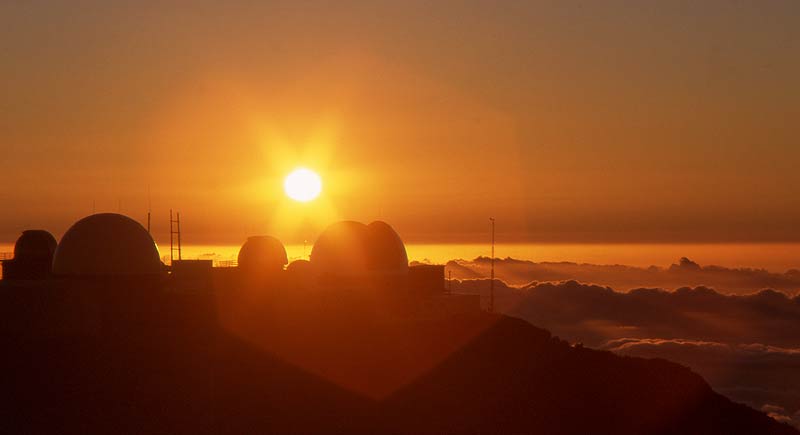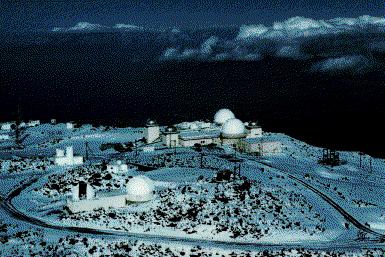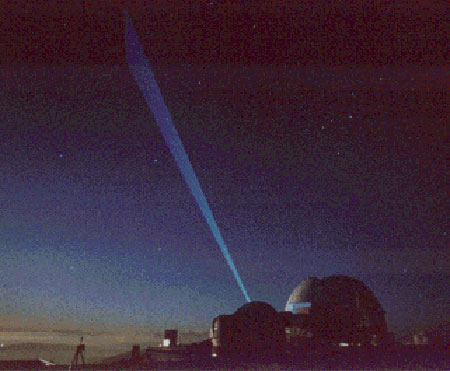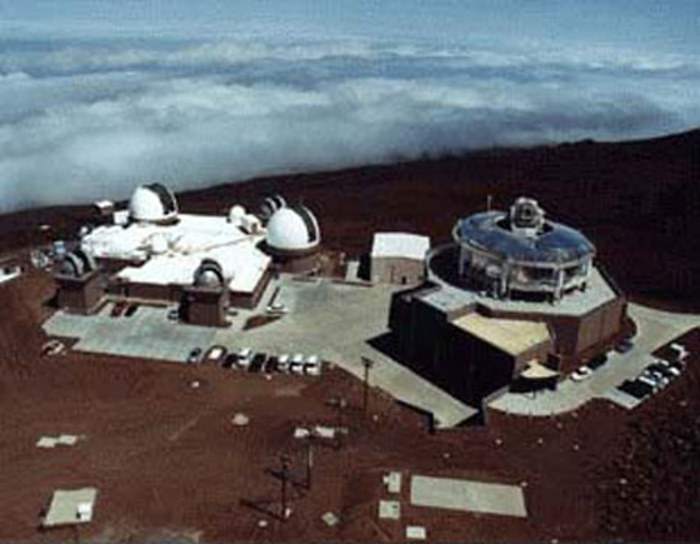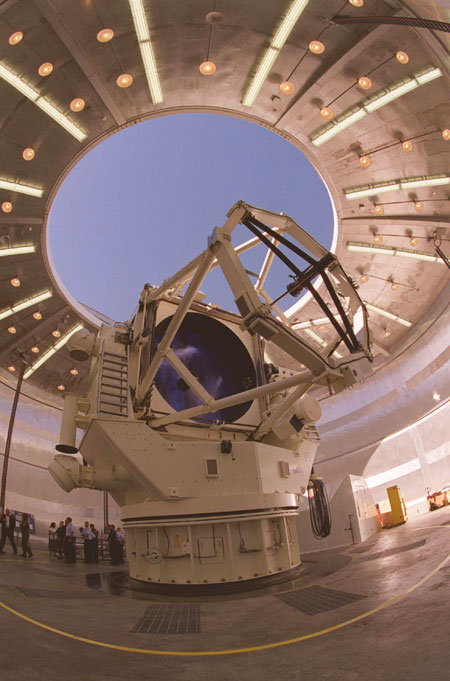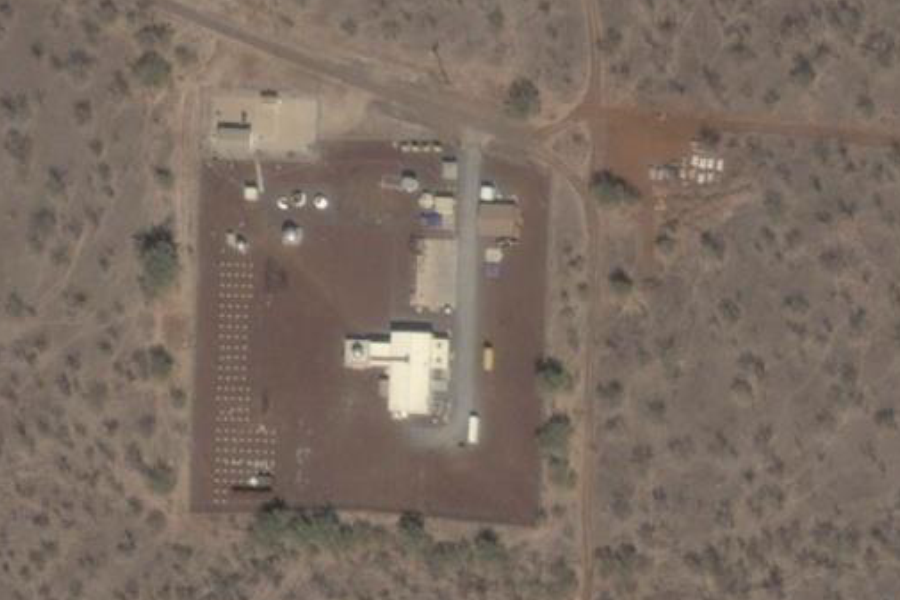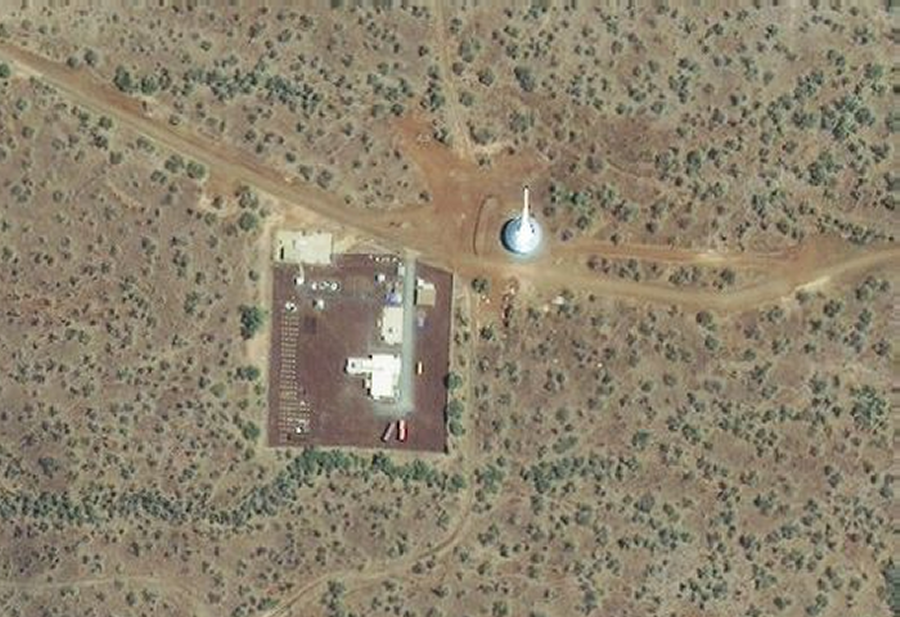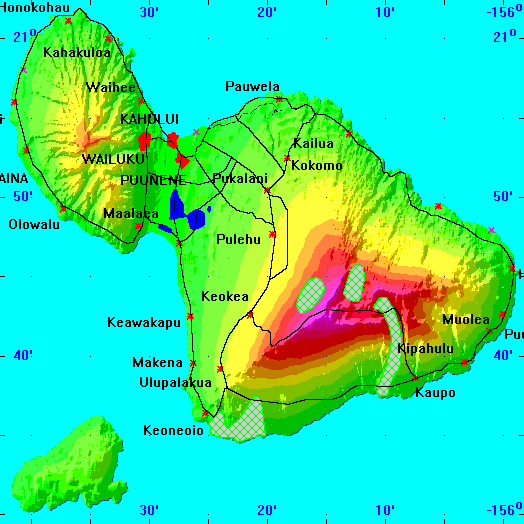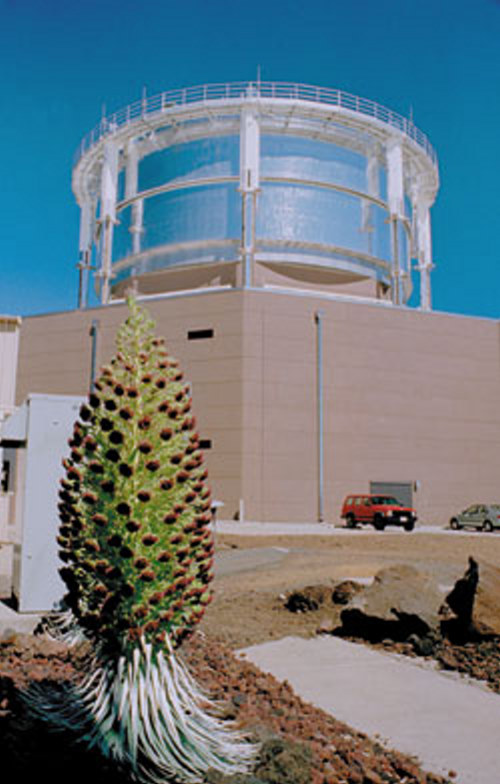|
Advanced Electro Optical System (AEOS) |
||||
|
Mount Haleakala, Maui, Hawaii
The Advanced Electro Optical System (AEOS) is a 3.67meter telescope space surveillance system specifically designed to improve the means of collecting, and the quality of, space data at the Maui Space Surveillance Complex facility in Hawaii. Primarily intended for Department of Defense space surveillance missions, the telescope is also used by scientific and academic astronomy communities from across the United States. The origins of AEOS began in the middle of the 1980s. At that time, the Air Force was trying to develop a groundbased laser antisatellite capability. Maui appealed to AEOS planners for several reasons. Its maritime location, coupled with its 10,000foot altitude, clear visibility, and location near the equator, made Haleakala a very stable environmental candidate. Taken together, these advantages made the site superb for routine observation of space objects. Work in support of the Western Test Range out of Vandenberg Air Force Base, California, and Barking Sands Missile Range on Kauai Island, Hawaii, and restricted airspace in this part of the Pacific Ocean also enhanced the site’s ability to meet its mission. The existing facilities at the Maui Space Surveillance Complex included the 1.6meter telescope, 1.2meter twin telescopes, Laser Beam Director, Beam Director/Tracker, and the Groundbased ElectroOptical Deep Space Surveillance System, as well as a proximity to the Maui High Performance Computing Center, made Maui even more attractive. SOURCE: AFRL Fact Sheet PDF Related Links
|
||||
| High Performance CO2 Laser Radar
(LADAR) (HI-CLASS) (U)
Description (U): (U) The Hi-CLASS effort is a Congressionally mandated program to build a CO2 laser at Maui Space Surveillance Site (MSSS) to work in conjunction with the Advanced Electro-Optical System (AEOS) passive sensor. Hi-CLASS is part of the Active Imaging Advanced Technology Development (ATD). Technology development is subsumed in the ATD phase because Critical Design Reviews (CDRs) have already been presented and equipment is being built. Predicted object metric measurement accuracies with Hi-CLASS are: range resolution of 2 m, velocity resolution of 1 m/s, and an angular resolution of 8 microradians. A detection range of 1500 km for 1 square meter target is expected, using 5 joule pulses. The operational system on the AEOS telescope should have capability to detect and track 10 cm class objects with 30 J pulses at 30 Hz. However, due to the narrow field of view (FOV), searching for such objects will be a problem. (U) Tests for the ATD will start after delivery of
the oscillator (wavelength tunable) in Jan-Feb 96, completing after delivery
of the amplifier. Direct costs for obtaining the device (design, tooling,
fabrication, and installation) is $35-40M. This includes the cost for checkout
and test to prove the design and perform the ATD. The ATD takes the majority
of the money and time because the ATD is supposed to develop the 30 J /30
Hz system and demonstrate it at the MSSS. The cost basis (ignoring inflation)
for operation and maintenance of the system is $1000 per night mount time
at 200 nights per year ($2M), operator and maintenance labor costs of $1M,
spares and supplies of $500K. Providing the unit is built and maintained
properly, it can last up to 20 years; especially if upgraded for longer
ranges. Although, in the 15-20 year time frame, the technology may become
badly dated. Some facilities use basic or advanced CMMS
software for ease of equipment operation and maintenance. CMMS is
computerized maintenance management system software which schedules and
records preventative and planned maintenance on facility equipment.
High
Performance CO2 Laser Radar (LADAR) (HI-CLASS) (U) - Global Security |
||||
|
Mount Haleakala Observatory +20° 42' 29.78", -156° 15' 24.04" \
The Air Force Maui Optical and Supercomputing (AMOS) observatory is an Air Force Research Laboratory (AFRL) operating location on Maui with a two-fold mission. First, it conducts the research and development mission on the Maui Space Surveillance System (MSSS) at the Maui Space Surveillance Complex (MSSC). Second, it oversees operation of the Maui High Performance Computing Center (MHPCC). AFRL's research and development mission on Maui was formally called AMOS; the use of the term AMOS has been widespread throughout the technical community for over thirty years and is still used today at many technical conferences. SOURCE: Wikipedia
|
||||
|
Maui Space Surveillance Site (MSSS)
The Maui Space Surveillance Site (MSSS) includes the Air Force Maui Optical Station (AMOS) is an asset of the US Air Force Materiel Command's Phillips Laboratory. the Maui Optical Tracking and Identification Facility (MOTIF), and a Ground-based Electro-Optical Deep Space Surveillance (GEODSS) site operated by US Air Force Space Command. Located at the summit of Haleakala, on the island of Maui, in the state of Hawaii, the facility is at an elevation of 3000 meters, and a latitude of 20.7 degrees north. This site is characterized by a relatively stable climate of clear, dry air, with low levels of particulants and minimal light pollution. The site is the only one of its kind in the world, combining operational satellite tracking facilities (MOTIF and GEODSS) with a research and development facility (AMOS). SOURCE: FAS.org Maui Space Surveillance System (MSSS) The accessibility and capability of the Maui Space Surveillance System provides an unequaled opportunity to the scientific community by combining state-of-the-art satellite tracking with a facility supporting research and development. The Maui Space Surveillance System, is routinely involved in numerous observing programs and has the capability of projecting lasers into the atmosphere, which is unusual at astronomical sites. Virtually year-round viewing conditions are possible due to the relatively stable climate. Dry, clean air and minimal scattered light from surface sources enable visibility exceeding 150 km. Based on double star observations, seeing is typically on the order of one second of arc. Situated at the crest of the dormant volcano Haleakala (IAU code 608), the observatory stands at an altitude of 3058 metres, latitude 20.7 degrees N, and longitude 156.3 degrees W. It is essentially co-located with IAU code 566, Haleakala-NEAT/GEODSS. In the process of accomplishing its mission, the observatory has discovered a number of asteroids. SOURCE: Wikipedia |
||||
Maui Space Surveillance Site
(MSSS)
The Maui Space Surveillance System (MSSS) is a state-of-the-art electro-optical facility combining operational satellite tracking facilities with a research and development facility, the only one of its kind in the world. The MSSS houses the largest telescope in the Department of Defense, the 3.67-meter Advanced Electro Optical System (AEOS), as well as several other telescopes ranging from 0.4 to 1.6 meters. SOURCE: Maui.AFMC.AF.mil
Please note: There are no public tours conducted at the Maui Space Surveillance System. Optical Assets Spanning over 30 years, the evolution of the Maui Space Surveillance System has demonstrated several stages in the history of space object tracking telescopes. Currently, through its primary mission for Air Force Space Command, the Maui Space Surveillance System combines large-aperture tracking optics with visible and infrared sensors to collect data on near Earth and deep-space objects. The 3.67-meter telescope, known as the Advanced Electro-Optical System (AEOS), owned by the Department of Defense, is the United States' largest optical telescope designed for tracking satellites. The 75-ton AEOS telescope points and tracks very accurately, yet is fast enough to track both low-Earth satellites and ballistic missiles. AEOS can be used simultaneously by many groups or institutions because its light can be channeled through a series of mirrors to seven independent coudé rooms below the telescope. Employing sophisticated sensors that include an adaptive optics system, radiometer, spectrograph, and long-wave infrared imager, the telescope tracks man-made objects in deep space and performs space object identification data collection. AEOS is equipped with an adaptive optics system, the heart of which is a 941-actuator deformable mirror that can change its shape to remove the atmosphere's distorting effects. Scientists are expected to get near diffraction-limited images of space objects. Other equipment at MSSS includes a 1.6-meter telescope, two 1.2-meter telescopes on a common mount, a 0.8-meter beam director/tracker, and a 0.6-meter laser beam director. The telescopes accommodate a wide variety of sensor systems, including imaging systems, conventional and contrast mode photometers, infrared radiometers, low light level video systems, and acquisition telescopes. In addition to these assets, the site has a machine shop, optics laboratories, and electronics laboratories. A Remote Maui Experimental (RME) site at sea level houses additional optics and electronics laboratories. This secondary observation station at Kihei bears IAU code 625 and is located at +20° 44' 46.00", -156° 25' 54.00" SOURCE: Wikipedia
AEOS 3.67-meter telescope is the largest in the Department of Defense. |
||||
|
Kihei, Hawaii +20° 44' 46.00", -156° 25' 54.00"
Remote Maui Experimental (RME) A Remote Maui Experimental (RME) site at sea level houses additional optics and electronics laboratories. This secondary observation station at Kihei bears IAU code 625 and is located at +20° 44' 46.00", -156° 25' 54.00"
|
||||
|
Maui High Performance Computing Center (MHPCC) An Air Force Research Laboratory Center Managed by
the University of Hawaii
Maui High Performance Computing Center (MHPCC) The Maui High Performance Computing Center (MHPCC) is an Air Force Research Laboratory center currently managed by the University of Hawaii and is located in the Maui Research and Technology Park in Kihei, Maui.[1] The MHPCC is a leading computing resource of the Department of Defense research and development community and operates numerous computer clusters, including a 5,120 processor Dell Poweredge cluster named "Jaws" which, as of November 2006, was the 11th most powerful computing systems in the world.[2][3] Chartered to sustain a broad base of users in the Department of Defense, government, academic, and commercial communities, MHPCC provides access to parallel computing hardware, advanced software tools and applications, high bandwidth communications, and high performance storage technologies. In addition, MHPCC offers a variety of services from its expert staff, including application support, parallel code development, large system management, and training and education programs. SOURCE: Wikipedia |
||||
| AFOSR: AEOS AT AMOS
AFOSR & NSF Joint Initiatives for U.S. Civilian Research at the 3.67m Advanced Electro-Optical System (AEOS) Telescope at the Air Force Maui Optical Station (AMOS) on Hawaii |
||||
|
..
The Maui Space Surveillance Site (MSSS) includes the Air Force Maui Optical Station (AMOS) is an asset of the US Air Force Materiel Command's Phillips Laboratory. the Maui Optical Tracking and Idntification Facility (MOTIF), and a Ground-based Electro-Optical Deep Space Surveillance (GEODSS) site operated by US Air Force Space Command. Located at the summit of Haleakala, on the island of Maui, in the state of Hawaii, the facility is at an elevation of 3000 meters, and a latitude of 20.7 degrees north. This site is characterized by a relatively stable climate of clear, dry air, with low levels of particulants and minimal light pollution. The site is the only one of its kind in the world, combining operational satellite tracking facilities (MOTIF and GEODSS) with a research and development facility (AMOS). The MSSS operates primarily at night, but performs many of its SOI missions 24 hours a day. The MSSS includes a number of sensors used for space tracking, imaging and object identification. It has two 1.2 meter telescopes that provide visual and infrared imaging, which means it can track during the day or night. The MSSS also uses a 1.6 meter telescope to perform day and night tracking and imaging. The MSSS is an optical system used primarily for spacetrack and imaging. It is capable of gathering data on both near and deep space objects at night or in daylight. The MSSS performs its mission using four electo-optical telescopes (a twin 1.2 meter, a 1.6 meter, and a 0.8 meter), and the future 3.7-meter telescope, timing systems, acquisition cameras, laser systems and communications systems for operations and Research and Development. Tracking is done in the polar and declination axes with the azimuth turntable set to a fixed position. The operator slews the telescope to the predicted track point. When the object comes into view, the operator steps the object into boresight and rate tracks it to collect metric and signature data. In addition, the system has a 0.6 meter laser beam director and a 0.8 meter beam director tracker, which can be used for tracking only. Air Force Research Laboratory periodically uses MSSS sensors for research experimentation, to include orbital debris research, earthcrossing asteroid search and tracking, and advanced imaging technology research. Integration of a ladar to the MSSS telescope will provide a 30-db signal-to-noise gain for space object engagements, followed by evaluation for range-Doppler imaging and space debris tracking applications. The system may also be used as a contributing sensor to the SSN SOURCE: Global Security.org |
||||
Rusian Academy of Science - Special Astrophysical Observatories The Maui Space Surveillance System (MSSS) is a state-of-the-art electro-optical facility combining operational satellite tracking facilities with a research and development facility, the only one of its kind in the world. The MSSS houses the largest telescope in the Department of Defense, the 3.67-meter Advanced Electro Optical System (AEOS), as well as several other telescopes ranging from 0.4 to 1.6 meters. Contact Air Force Research Laboratory |
||||
| FAIR USE NOTICE: This page contains copyrighted material the use of which has not been specifically authorized by the copyright owner. Pegasus Research Consortium distributes this material without profit to those who have expressed a prior interest in receiving the included information for research and educational purposes. We believe this constitutes a fair use of any such copyrighted material as provided for in 17 U.S.C § 107. If you wish to use copyrighted material from this site for purposes of your own that go beyond fair use, you must obtain permission from the copyright owner. | ||||
|
|
